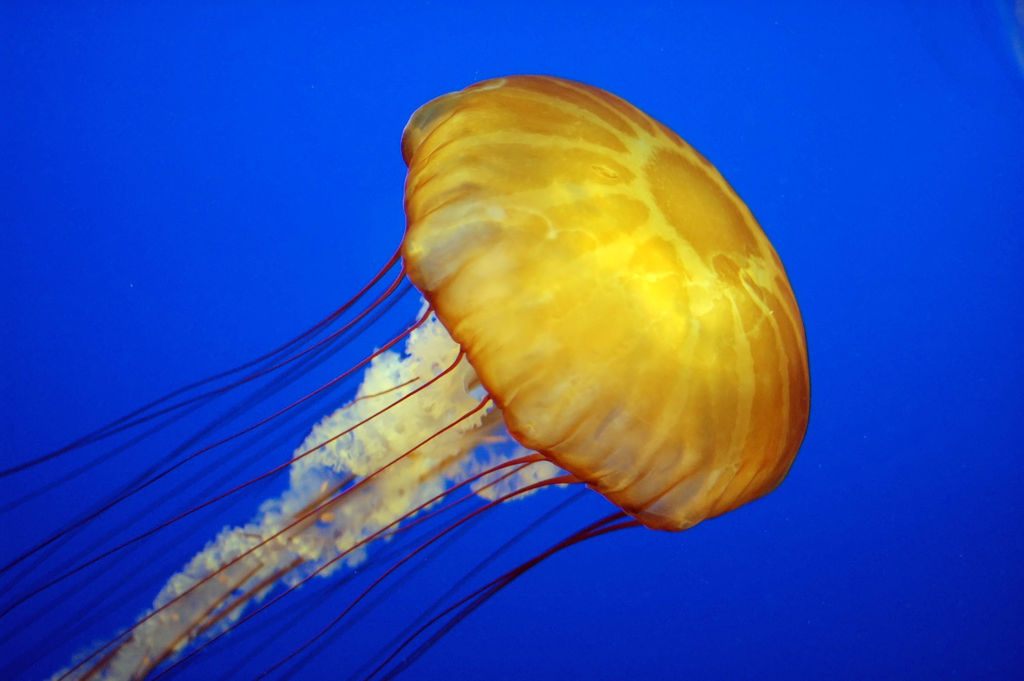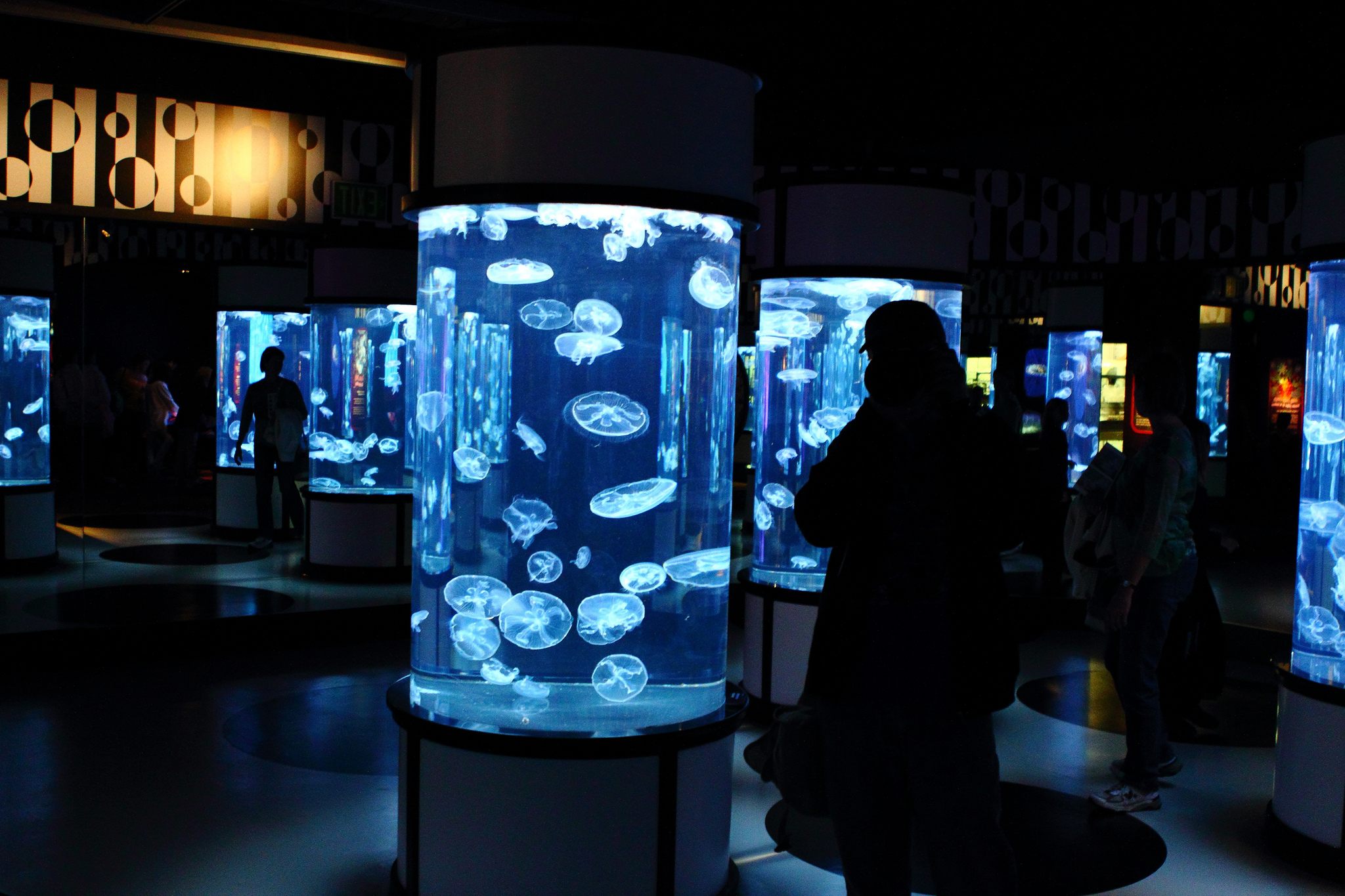How Jellyfish Exhibits Became Underwater Dance Clubs

Infinite blue in action. (Photo: Dan90266/WikiCommons CC BY-SA 2.0)
Jellyfish are, with all due respect, incredibly weird. They’re 95 percent water, and spend their lives being pulled to and fro by currents. They can’t see or hear, they never sleep, and, in a staggering display of unrelatability, some of them don’t even die. The creatures have one-way digestive systems, which means they use their mouths to eat, poop, and reproduce. The life cycle of your average jellyfish involves six stages, only one of which manifests as the tentacled bulb most of us are familiar with (another involves a baby jelly cloning itself into what looks like a stack of warty pancakes). Plus, they’ve probably ruined your beach day at least once.
These days, when aquariums want to teach the public about jellyfish, they turn their tanks into neon spectacles that look less like traditional exhibits and more like many-fronded, freaky-deaky dance clubs. At this very moment, interested parties can get their gelatinous groove on at jellyfish exhibits in many cities around the world.
The Monterey Bay aquarium recently had “The Jellies Experience,” a Hendrix-inspired special exhibit which promises kaleidoscopic displays and a “sensory extravaganza” of “psychedelic glory.” (It closed in September, but you can still visit Monterey Bay’s permanent “Drifters” gallery, or watch their live jelly cam). There’s a vaguely brothel-themed jelly gallery in Kentucky, and a neon, labyrinthine ”garden” in Hong Kong. At least one couple has swapped marriage vows in front of the Georgia Aquarium’s fluorescent, wall-sized tank. But how exactly did tanks full of translucent, bobbing creatures become underwater raves?
Creative types have been inspired by jellyfish for at least a century, ever since German artist-biologist Ernst Haeckel drew attention to their elegant symmetries. But the live-art revolution has all happened over the past couple of decades. “It all sort of started with the kreisel tank,” explained Steve Spina, jellyfish supervisor for the New England Aquarium, during a talk last week at Le Laboratoire Cambridge.
A German marine biologist named Wolf Greve invented the kreisel tank in 1969, so that he could take his studies of Arctic jellyfish back to the lab. Unlike in more stagnant setups, the water in a kreisel tank rotates gently, helping the low-powered creatures to move around (“kreisel” is German for “gyroscope”). It’s a slow flow—“you don’t want it whirling around like they’re in a washing machine,” Spina said—but unlike in still water, where jellies would drift to the bottom, ”they will stay aloft on their own.”
The streamlined, minimalist design, with its separate compartment for hardware, also discourages its fragile inhabitants from smashing into the walls or getting sucked into the filter.

A kreisel tank, household-sized. (Photo: Edilbarto “Pay” Aponte/WikiCommons CC BY-SA 4.0)
Before the kreisel, people considered it impossible to keep jellyfish in captivity. Afterwards, researchers and aficionados started rejiggering it for their own purposes, and soon the delicate animals were ensconced in lab tanks and onboard marine collection ships all over the world.
In the early 1990s, specialists at the Monterey Bay Aquarium decided to use the technology to put on the first ever large-scale jellyfish exhibit, a feat requiring biological and visual innovations. “They kind of refined the aesthetics of displaying these animals,” Spina said.
They developed different tank shapes (the gently rectangular “stretch kreisel,” for example) and they invented what’s called “the Infinite Blue background”—that peaceful, translucent cerulean that masks the back wall of pretty much every contemporary jellyfish tank. It’s just a sheet of acrylic, said Spina, but standing in front of it makes you feel like “you’re looking at a slice of the ocean.”

Visitors groove near the moon jelly columns at the Monterey Bay Aquarium. (Photo: Justin Ennis/Flickr)
The Monterey Bay Aquarium’s 1992 show, “Planet of the Jellies,” gave other aquariums that jealous sting. The experts there shared their tricks, and soon tentacled blobs were revolving mildly in front of rapt spectators across the globe. Twenty years later, the jellies haven’t lost their appeal, said Spina—they regularly beat out more immediately charismatic animals, like sharks and penguins, in visitor polls. In 2012, Japan’s Kamo Aquarium turned near-bankruptcy into wild success by transforming their entire building into the world’s largest jellyfish collection.
The habits and characteristics that make jellyfish so alien-seeming also allow exhibit designers to tap into a type of aesthetic that wouldn’t necessarily work with other creatures. Most animals need rocks, plants, or other shelter to be happy, but jellyfish prefer austerity—after all, a single bubble can kill them. On the other hand, they’re undisturbed by blacklights or strobes (in fact, the blacklights in “The Jellies Experience” allowed scientists at Monterey Bay to discover a never-before-seen life stage of a particular species).
Even as many zoos and aquariums shift towards exhibits that display multiple species, the jellies stand alone—otherwise, they’d get get eaten. But they’re easy to feed, require no individual attention, and are often cultured in-house, so tens of thousands can be displayed at once. Overall, perfect disco conditions.

A tank of disco jellies at the Monterey Bay Aquarium. (Photo: David Goehring/Flickr)
Those huge, pulsing clouds of identical jellies have another, more educational effect—they mirror the potential consequences of climate change. Jellyfish, who are as chemically hardy as they are physically delicate, are a kind of anti-canary, showing up in droves while other species die out.
“When they start appearing in huge numbers, that’s a sign of trouble” in an ecosystem, says Spina, who adds that because of intercontinental travel and changing currents, jellies “have really invaded a lot of other places where they don’t belong.”
Jellyfish dance clubs are great in aquariums, but if the whole ocean starts swarming with gooey ravers, that means it’s time to face the music.
Update, 10/19: The original version of this article intimated that the Monterey Bay Aquarium’s “The Jellies Experience” is still open; it actually closed in September. We regret the error.















Follow us on Twitter to get the latest on the world's hidden wonders.
Like us on Facebook to get the latest on the world's hidden wonders.
Follow us on Twitter Like us on Facebook